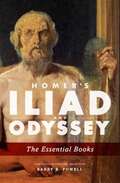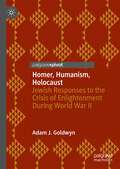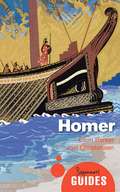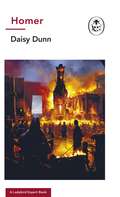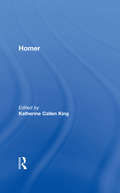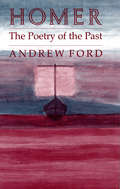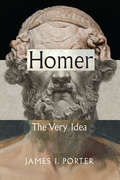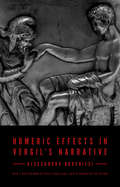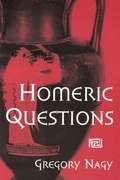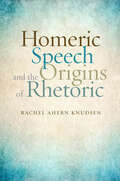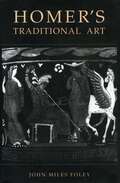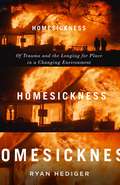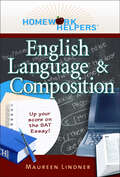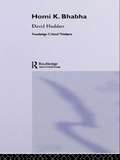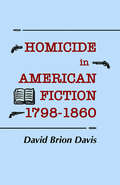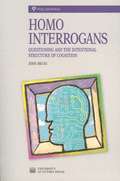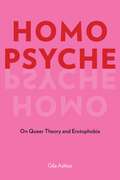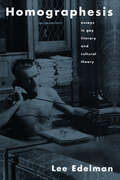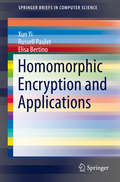- Table View
- List View
Homer's Iliad And Odyssey: The Essential Books
by Barry B. PowellRenowned Homer scholar Barry B. Powell has already given the world powerful new translations of the Iliad and the Odyssey. Now his Homer's Iliad and Odyssey: The Essential Books brings together his translations of the most important books and passages from these two great poems in one handy volume. Accessible, poetic, and accurate, Barry Powell's translations are an excellent fit for today's students. With swift, transparent language that rings both ancient and modern, Powell exposes students to all of the rage, pleasure, pathos, cunning, and humor that are Homer's Iliad and Odyssey. Both the translations and the introductions are informed by the best recent scholarship.
Homer's Odyssey and the Near East
by Bruce LoudenThe Odyssey's larger plot is composed of a number of distinct genres of myth, all of which are extant in various Near Eastern cultures (Mesopotamian, West Semitic, Egyptian). Unexpectedly, the Near Eastern culture with which the Odyssey has the most parallels is the Old Testament. Consideration of how much of the Odyssey focuses on non-heroic episodes - hosts receiving guests, a king disguised as a beggar, recognition scenes between long-separated family members - reaffirms the Odyssey's parallels with the Bible. In particular the book argues that the Odyssey is in a dialogic relationship with Genesis, which features the same three types of myth that comprise the majority of the Odyssey: theoxeny, romance (Joseph in Egypt), and Argonautic myth (Jacob winning Rachel from Laban). The Odyssey also offers intriguing parallels to the Book of Jonah, and Odysseus' treatment by the suitors offers close parallels to the Gospels' depiction of Christ in Jerusalem.
Homer's The Iliad and The Odyssey: A Biography
by Alberto ManguelIn this Book, Alberto Manguel traces the lineage of the epic poems. He considers their original purpose, either as allegory or record of history, surveys the challenges the pagan poems presented to the early Christian world, and traces their spread after the Reformation.
Homer, Humanism, Holocaust: Jewish Responses to the Crisis of Enlightenment During World War II
by Adam J. GoldwynThis book examines how Jewish intellectuals during and after the Second World War reinterpreted Homer’s epics, the Iliad and the Odyssey, in light of their own wartime experiences, drawing a parallel between the ancient Greek genocide of the Trojans and the Nazi genocide of the Jews. The wartime writings of Theodore Adorno, Hannah Arendt, Erich Auerbach, Rachel Bespaloff, Hermann Broch, Max Horkheimer, Primo Levi, and others were attempts both to understand the collapse of European civilization and the Enlightenment through critiques of their foundational texts and to imagine the place of the Homeric epics in a new post-War humanism. The book thus also explores the reception of these writers, analyzing how Jewish child-survivors like Geoffrey Hartman and Hélène Cixous and writers of the post-Holocaust generation like Daniel Mendelsohn continued to read the epics as narratives of grief, trauma, and woundedness into the twenty-first century..
Homer: A Beginner's Guide (Beginner's Guides)
by Joel Christensen Elton Te BakerWidely revered as the father of Western literature, Homer was the author of The Iliad and The Odyssey, the epic poems which immortalized such names as Cyclops, Menelaus, and Achilles, and inspired such films as the Brad Pitt blockbuster Troy. In this vivid introduction, Elton Barker and Joel Christensen celebrate the complexity, innovation and sheer excitement of Homer's two great works, and investigate the controversy surrounding the man behind the myths - asking who he was and whether he even existed.From soap operas to Salman Rushdie, the authors also highlight just how much we owe Homer and why he has been so influential. Perfect for new readers of the great poet but full of insights that will delight Homeric experts, it will inspire you to discover (or rediscover) his epic masterpieces first-hand.
Homer: A Ladybird Expert Book (The Ladybird Expert Series #38)
by Daisy DunnPart of the ALL-NEW LADYBIRD EXPERT SERIES'Brought evocatively to life' HISTORY REVEALED- Was there really a Trojan War?- What makes a Homeric hero?- How did Odysseus defeat the Cyclops?IMMERSE yourself in the epic adventures of the Ancient Greek gods and heroes. Filled with daring feats, battles and terrifying monsters, the poems and the stories told within them raise complex questions about fate, death and forgiveness that are still debated today.MIGHTY HEROES AND MEDDLING GODSWritten by the winner of the Classical Association Prize 2020, Daisy Dunn's Homer is a fascinating introduction to these ancient stories and their truly timeless themes.
Homer: Paradigms Of The War Hero From Homer To The Middle Ages
by Katherine Callen KingFirst Published in 1994. Routledge is an imprint of Taylor & Francis, an informa company.
Homer: The Poetry of the Past
by Andrew FordAndrew Ford here addresses, in a manner both engaging and richly informed, the perennial questions of what poetry is, how it came to be, and what it is for. Focusing on the critical moment in Western literature when the heroic tales of the Greek oral tradition began to be preserved in writing, he examines these questions in the light of Homeric poetry. Through fresh readings of the Iliad and the Odyssey, and referring to other early epics as well, Ford deepens our understanding of what poetry was at a time before written texts, before a developed sense of authorship, and before the existence of institutionalized criticism.Placing what is known about Homer's art in the wider context of Homer's world, Ford traces the effects of the oral tradition upon the development of the epic and addresses such issues as the sources of the poet's inspiration and the generic constraints upon epic composition. After exploring Homer's poetic vocabulary and his fictional and mythical representations of the art of singing, Ford reconstructs an idea of poetry much different from that put forth by previous interpreters. Arguing that Homer grounds his project in religious rather than literary or historical terms, he concludes that archaic poetry claims to give a uniquely transparent and immediate rendering of the past.Homer: The Poetry of the Past will be stimulating and enjoyable reading for anyone interested in the traditions of poetry, as well as for students and scholars in the fields of classics, literary theory and literary history, and intellectual history.
Homer: The Very Idea
by James I. PorterThe story of our ongoing fascination with Homer, the man and the myth. Homer, the great poet of the Iliad and the Odyssey, is revered as a cultural icon of antiquity and a figure of lasting influence. But his identity is shrouded in questions about who he was, when he lived, and whether he was an actual person, a myth, or merely a shared idea. Rather than attempting to solve the mystery of this character, James I. Porter explores the sources of Homer’s mystique and their impact since the first recorded mentions of Homer in ancient Greece. Homer: The Very Idea considers Homer not as a man, but as a cultural invention nearly as distinctive and important as the poems attributed to him, following the cultural history of an idea and of the obsession that is reborn every time Homer is imagined. Offering novel readings of texts and objects, the book follows the very idea of Homer from his earliest mentions to his most recent imaginings in literature, criticism, philosophy, visual art, and classical archaeology.
Homeric Effects in Vergil's Narrative
by Philip Hardie Ilaria Marchesi Alessandro BarchiesiThe study of Homeric imitations in Vergil has one of the longest traditions in Western culture, starting from the very moment the Aeneid was circulated. Homeric Effects in Vergil's Narrative is the first English translation of one of the most important and influential modern studies in this tradition. In this revised and expanded edition, Alessandro Barchiesi advances innovative approaches even as he recuperates significant earlier interpretations, from Servius to G. N. Knauer.Approaching Homeric allusions in the Aeneid as "narrative effects" rather than glimpses of the creative mind of the author at work, Homeric Effects in Vergil's Narrative demonstrates how these allusions generate hesitations and questions, as well as insights and guidance, and how they participate in the creation of narrative meaning. The book also examines how layers of competing interpretations in Homer are relevant to the Aeneid, revealing again the richness of the Homeric tradition as a component of meaning in the Aeneid. Finally, Homeric Effects in Vergil's Narrative goes beyond previous studies of the Aeneid by distinguishing between two forms of Homeric intertextuality: reusing a text as an individual model or as a generic matrix. For this edition, a new chapter has been added, and in a new afterword the author puts the book in the context of changes in the study of Latin literature and intertextuality. A masterful work of classical scholarship, Homeric Effects in Vergil's Narrative also has valuable insights for the wider study of imitation, allusion, intertextuality, epic, and literary theory.
Homeric Questions
by Gregory NagyThe "Homeric Question" has vexed Classicists for generations. Was the author of the Iliad and the Odyssey a single individual who created the poems at a particular moment in history? Or does the name "Homer" hide the shaping influence of the epic tradition during a long period of oral composition and transmission?<P><P>In this innovative investigation, Gregory Nagy applies the insights of comparative linguistics and anthropology to offer a new historical model for understanding how, when, where, and why the Iliad and the Odyssey were ultimately preserved as written texts that could be handed down over two millennia. His model draws on the comparative evidence provided by living oral epic traditions, in which each performance of a song often involves a recomposition of the narrative.
Homeric Speech and the Origins of Rhetoric
by Rachel Ahern KnudsenKnudsen argues that Homeric epics are the locus for the origins of rhetoric.Traditionally, Homer's epics have been the domain of scholars and students interested in ancient Greek poetry, and Aristotle's rhetorical theory has been the domain of those interested in ancient rhetoric. Rachel Ahern Knudsen believes that this academic distinction between poetry and rhetoric should be challenged. Based on a close analysis of persuasive speeches in the Iliad, Knudsen argues that Homeric poetry displays a systematic and technical concept of rhetoric and that many Iliadic speakers in fact employ the rhetorical techniques put forward by Aristotle.Rhetoric, in its earliest formulation in ancient Greece, was conceived as the power to change a listener’s actions or attitudes through words—particularly through persuasive techniques and argumentation. Rhetoric was thus a "technical" discipline in the ancient Greek world, a craft (technê) that was rule-governed, learned, and taught. This technical understanding of rhetoric can be traced back to the works of Plato and Aristotle, which provide the earliest formal explanations of rhetoric. But do such explanations constitute the true origins of rhetoric as an identifiable, systematic practice? If not, where does a technique-driven rhetoric first appear in literary and social history? Perhaps the answer is in Homeric epics. Homeric Speech and the Origins of Rhetoric demonstrates a remarkable congruence between the rhetorical techniques used by Iliadic speakers and those collected in Aristotle's seminal treatise on rhetoric. Knudsen's claim has implications for the fields of both Homeric poetry and the history of rhetoric. In the former field, it refines and extends previous scholarship on direct speech in Homer by identifying a new dimension within Homeric speech—namely, the consistent deployment of well-defined rhetorical arguments and techniques. In the latter field, it challenges the traditional account of the development of rhetoric, probing the boundaries that currently demarcate its origins, history, and relationship to poetry.
Homer’s Traditional Art (G - Reference, Information and Interdisciplinary Subjects)
by John Miles FoleyIn recent decades, the evidence for an oral epic tradition in ancient Greece has grown enormously along with our ever-increasing awareness of worldwide oral traditions. John Foley here examines the artistic implications that oral tradition holds for the understanding of the Iliad and Odyssey in order to establish a context for their original performance and modern-day reception.In Homer's Traditional Art, Foley addresses three crucially interlocking areas that lead us to a fuller appreciation of the Homeric poems. He first explores the reality of Homer as their actual author, examining historical and comparative evidence to propose that "Homer" is a legendary and anthropomorphic figure rather than a real-life author. He next presents the poetic tradition as a specialized and highly resonant language bristling with idiomatic implication. Finally, he looks at Homer's overall artistic achievement, showing that it is best evaluated via a poetics aimed specifically at works that emerge from oral tradition.Along the way, Foley offers new perspectives on such topics as characterization and personal interaction in the epics, the nature of Penelope's heroism, the implications of feasting and lament, and the problematic ending of the Odyssey. His comparative references to the South Slavic oral epic open up new vistas on Homer's language, narrative patterning, and identity.Homer's Traditional Art represents a disentangling of the interwoven strands of orality, textuality, and verbal art. It shows how we can learn to appreciate how Homer's art succeeds not in spite of the oral tradition in which it was composed but rather through its unique agency.
Homes and Homecomings: Gendered Histories of Domesticity and Return (Gender and History Special Issues #7)
by K. H. Adler Carrie HamiltonIn Homes and Homecomings an international group of scholars provide inspiring new historical perspectives on the politics of homes and homecomings. Using innovative methodological and theoretical approaches, the book examines case studies from Africa, Asia, the Americas and Europe. Provides inspiring new historical perspectives on the politics of homes and homecomings Takes an historical approach to a subject area that is surprisingly little historicised Features original research from a group of international scholars The book has an international approach that focuses on Africa, Asia, the Americas and East and West Europe Contains original illustrations of homes in a variety of historical contexts
Homesickness
by Carlos RojasCarlos Rojas focuses on the trope of "homesickness" in China--discomfort caused not by a longing for home but by excessive proximity to it. This inverse homesickness marks a process of movement away from the home, conceived of as spaces associated with the nation, family, and individual body, and gives rise to the possibility of long-term health.
Homesickness: Of Trauma and the Longing for Place in a Changing Environment
by Ryan HedigerIntroducing a posthumanist concept of nostalgia to analyze steadily widening themes of animality, home, travel, slavery, shopping, and war in U.S. literature after 1945 In the Anthropocene, as climate change renders environments less stable, the human desire for place underscores the weakness of the individual in the face of the world. In this book, Ryan Hediger introduces a distinctive notion of homesickness, one in which the longing for place demonstrates not only human vulnerability but also intersubjectivity beyond the human. Arguing that this feeling is unavoidable and characteristically posthumanist, Hediger studies the complex mix of attitudes toward home, the homely, and the familiar in an age of resurgent cosmopolitanism, especially eco-cosmopolitanism. Homesickness closely examines U.S. literature mostly after 1945, including prominent writers such as Annie Proulx, Marilynne Robinson, and Ernest Hemingway, in light of the challenges and themes of the Anthropocene. Hediger argues that our desire for home is shorthand for a set of important hopes worth defending—serious and genuine relationships to places and their biotic regimes and landforms; membership in vital cultures, human and nonhuman; resistance to capital-infused forms of globalization that flatten differences and turn life and place into mere resources. Our homesickness, according to Hediger, is inevitable because the self is necessarily constructed with reference to the material past. Therefore, homesickness is not something to dismiss as nostalgic or reactionary but is rather a structure of feeling to come to terms with and even to cultivate.Recasting an expansive range of fields through the lens of homesickness—from ecocriticism to animal studies and disability studies, (eco)philosophy to posthumanist theory—Homesickness speaks not only to the desire for a physical structure or place but also to a wide range of longings and dislocations, including those related to subjectivity, memory, bodies, literary form, and language.
Homework Helpers: English Language & Composition (Homework Helpers)
by Maureen LindnerEssential preparation for the new SAT Writing and Grammar Section. Homework Helpers: English Language & Composition is a user-friendly review book that will make any student—or those trying to help them—feel like he or she has a private tutor. Each chapter includes detailed questions that allow students to assess how well they've mastered each idea. Not only does the author provide the right answers to these self-study questions, but also detailed explanations of why the wrong answers are wrong. When is a comma used? Why are some titles capitalized? How are dangling modifiers prevented? There are hundreds of grammatical and compositional rules, many of them difficult to understand and memorize. And just as many exceptions to the rules! Homework Helpers: English Language and Composition focuses on all aspects of writing, with clear lessons and exercises on:• Parts of speech• Punctuation• Tone• The writing process• Types of sentences• Types of essays• Revisions• Common errors to avoid Students from high school through college will find this book to be an essential writing tool. Younger students can follow the lessons from beginning to end to learn everything they need to know about language and composition. The more experienced student can pick and choose lessons and exercises according to need—especially if they're facing the new SAT. The Homework Helpers Series is just what students need to boost their confidence and give them the help they need to ace even the most challenging classes and tests.
Homi K. Bhabha (Routledge Critical Thinkers)
by David HuddartHomi K. Bhabha is one of the most highly renowned figures in contemporary post-colonial studies. This volume explores his writings and their influence on postcolonial theory, introducing in clear and accessible language the key concepts of his work, such as 'ambivalence', 'mimicry', 'hybridity' and 'translation'. David Huddart draws on a range of contexts, including art history, contemporary cinema and canonical texts in order to illustrate the practical application of Bhabha's theories. This introductory guidebook is ideal for all students working in the fields of literary, cultural and postcolonial theory.
Homicide in American Fiction, 1798–1860: A Study in Social Values
by David Brion DavisHomicide has many social and psychological implications that vary from culture to culture and which change as people accept new ideas concerning guilt, responsibility, and the causes of crime. A study of attitudes toward homicide is therefore a method of examining social values in a specific setting. Homicide in American Fiction, 1798–1860 is the first book to contrast psychological assumptions of imaginative writers with certain social and intellectual currents in an attempt to integrate social attitudes toward such diverse subjects as human evil, moral responsibility, criminal insanity, social causes of crime, dueling, lynching, the "unwritten law" of a husband's revenge, and capital punishment. In addition to works of literary distinction by Cooper, Hawthorne, Irving, and Poe, among others, Davis considers a large body of cheap popular fiction generally ignored in previous studies of the literature of this period. This is an engrossing study of fiction as a reflection of and a commentary on social problems and as an influence shaping general beliefs and opinions.
Homo Interrogans: Questioning and the Intentional Structure of Cognition
by John BruinEmerging from the Brentano-Husserl tradition, this volume charts new ground in the conceptual discourse of questioning and answering. John Bruin examines the "logic" of interrogation and makes the case that intentionality itself has the structure of question and answer. Here, he breaks rank with the better known and more traditional and sets out to explore questioning from a phenomenological perspective.
Homo Psyche: On Queer Theory and Erotophobia
by Gila AshtorWinner, Alan Bray Memorial Book Award2022 Lammy Finalist, LGBTQ StudiesCan queer theory be erotophobic? This book proceeds from the perplexing observation that for all of its political agita, rhetorical virtuosity, and intellectual restlessness, queer theory conforms to a model of erotic life that is psychologically conservative and narrow. Even after several decades of combative, dazzling, irreverent queer critical thought, the field remains far from grasping that sexuality’s radical potential lies in its being understood as “exogenous, intersubjective and intrusive” (Laplanche). In particular, and despite the pervasiveness and popularity of recent calls to deconstruct the ideological foundations of contemporary queer thought, no study has as yet considered or in any way investigated the singular role of psychology in shaping the field’s conceptual impasses and politico-ethical limitations.Through close readings of key thinkers in queer theoretical thought—Eve Kosofsky Sedgwick, Leo Bersani, Lee Edelman, Judith Butler, Lauren Berlant, and Jane Gallop—Homo Psyche introduces metapsychology as a new dimension of analysis vis-à-vis the theories of French psychoanalyst Jean Laplanche, who insisted on “new foundations for psychoanalysis” that radically departed from existing Freudian and Lacanian models of the mind. Staging this intervention, Ashtor deepens current debates about the future of queer studies by demonstrating how the field’s systematic neglect of metapsychology as a necessary and independent realm of ideology ultimately enforces the complicity of queer studies with psychological conventions that are fundamentally erotophobic and therefore inimical to queer theory’s radical and ethical project.
Homographesis: Essays in Gay Literary and Cultural Theory
by Lee EdelmanFirst published in 1994. Routledge is an imprint of Taylor & Francis, an informa company.
Homomorphic Encryption and Applications
by Elisa Bertino Xun Yi Russell PauletThis book introduces the fundamental concepts of homomorphic encryption. From these foundations, applications are developed in the fields of private information retrieval, private searching on streaming data, privacy-preserving data mining, electronic voting and cloud computing. The content is presented in an instructional and practical style, with concrete examples to enhance the reader's understanding. This volume achieves a balance between the theoretical and the practical components of modern information security. Readers will learn key principles of homomorphic encryption as well as their application in solving real world problems.
Homophones Visualized
by Bruce WordenA witty illustrated guide to words that sound alike, but are spelled differently and have completely different meanings. Do ewe no what homophones are? They&’re words that sound alike but are spelled differently and have completely different meanings—it&’s knot always easy to get it right. Based on his blog Homophones, Weakly, Bruce Worden&’s Homophones Visualized uses simple but clever graphics to help illustrate the differences between 100 pairs (or triplets or quadruplets) of words that sound alike. From beat and beet to flee and flea, baron and barren to golf and gulf, each spread contains a pair or group of homophones and corresponding illustrations that provide context for each word. Word lovers, educators, and kids all will delight in this witty and useful homophone guide to understanding which word is witch. Praise for Homophones Visualized &“My daughters and I read through the entire book together in one sitting, enjoying the clever wordplay. I particularly liked it when Worden was able to make similar-looking illustrations for a pair of homophones, with just subtle changes to reflect the differences in meanings. Whether you enjoy wordplay and puns, or if you just have a hard time remembering the difference between &“affect&” and &“effect,&” this book is for you!&” —GeekDad
Homosexualities and French Literature: Cultural Contexts, Critical Texts
by George Stambolian Elaine MarksHow significant a role does homosexuality play in the work of an individual writer? Is there a homosexual imagination, a creative impulse that can be described as distinctly homosexual? What effect have the women's and gay liberation movements had on the context of literary discussion? This provocative and ground-breaking volume confronts such questions head-on in offering a wide diversity of perspectives on the relationship of homosexuality--as a literary, social, psychological, and political phenomenon--to the rich corpus of French literature and critical theory. It consists of six interviews and fifteen essays, all but one of which were written expressly for this volume, representing a variety of critical approaches. Among the contributors to the first part, "Cultural Contexts," are leading psychoanalysts, feminists, writers, and thinkers in France and the United States. In essays and interviews, they raise important questions about the interaction of discourse with sexuality, desire, oppression, and consciousness. The essays in the second part, "Critical Texts," focus on the works of individual writers from the eighteenth century to the present. They reveal how 7 poets and novelists, in struggling with language, made use of, and irrevocably altered, the literary conventions and psychological preconceptions of their time. Among the authors treated are the Marquis de Sade, George Sand, Baudelaire, Proust, Gide, Colette, Cocteau, Sartre, Genet, Violette Leduc, and Monique Wittig.
